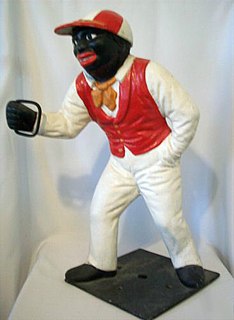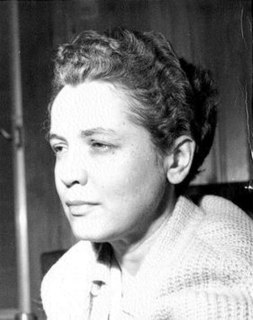Related Research Articles

Mary Flannery O'Connor was an American novelist, short story writer and essayist. She wrote two novels and 31 short stories, as well as a number of reviews and commentaries.

Wise Blood is the first novel by American author Flannery O'Connor, published in 1952. The novel was assembled from disparate stories first published in Mademoiselle, Sewanee Review and Partisan Review. The first chapter is an expanded version of her Master's thesis, "The Train", and other chapters are reworked versions of "The Peeler," "The Heart of the Park" and "Enoch and the Gorilla". The novel concerns a returning World War II veteran who, haunted by a life-long crisis of faith, resolves to form an anti-religious ministry in an eccentric, fictionalized Southern city after finding his family homestead abandoned without a trace.

A lawn jockey is a statue depicting a man in jockey clothes, intended to be placed in front yards as hitching posts, similar to those of footmen bearing lanterns near entrances and gnomes in gardens. Because of the prevalence of black lawn jockeys with exaggerated features, the item is often regarded as being symbolic of the racism and racist imagery prevalent in the United States during the eras of slavery and Jim Crow laws. Today, lawn jockeys are often depicted as Caucasian boys to distance the artifact from racial connotations.

A chifforobe, also chiffarobe or chifferobe, is a closet-like piece of furniture that combines a long space for hanging clothes with a chest of drawers. Typically the wardrobe section runs down one side of the piece, while the drawers occupy the other side. It may have two enclosing doors or have the drawer fronts exposed and a separate door for the hanging space.

Wise Blood is a 1979 black-comedy drama film directed by John Huston and starring Brad Dourif, Dan Shor, Amy Wright, Harry Dean Stanton, and Ned Beatty. It is based on the 1952 novel Wise Blood by Flannery O'Connor. As a co-production with Germany the film was titled Der Ketzer or Die Weisheit des Blutes when released in Germany, and Le Malin when released in France.

Andalusia is the name of Southern American author Flannery O'Connor's rural Georgia estate. The estate is located in Baldwin County, Georgia, approximately 4 miles (6.4 km) northwest of Milledgeville. It comprises 544 acres (2.20 km2), including the plantation house where O'Connor wrote some of her last and best-known fiction.

Hazel Elizabeth Hester was an American correspondent of influential twentieth-century writers, including Flannery O'Connor and Iris Murdoch. Hester wrote several short stories, poems, diaries, and philosophical essays, none of which were published.

"Revelation" is a Southern Gothic short story by author Flannery O'Connor about the delivery and effect of a revelation to a sinfully proud, self-righteous, middle-aged, middle class, rural, white Southern woman that her confidence in her own Christian salvation is an error. The protagonist receives divine grace by accepting God's judgment that she is unfit for salvation, by learning that the prospect for her eventual redemption improves after she receives a vision of Particular Judgment, where she observes the souls of people she detests are the first to ascend to Heaven and those of people like herself who "always had a little of everything and the God-given wit to use it right" are last to ascend and experience purgation by fire on the way up.

"A Good Man Is Hard to Find" is a Southern gothic short story first published in 1953 by author Flannery O'Connor who, in her own words, described it as "the story of a family of six which, on its way driving to Florida [from Georgia], gets wiped out by an escaped convict who calls himself the Misfit".
The bibliography of Flannery O'Connor includes two novels, more than thirty short stories, and several collections.
"The Train" is an early short story by the American author Flannery O'Connor. It is one of the six stories included in O'Connor's 1947 master's thesis The Geranium: A Collection of Short Stories and was published in The Sewanee Review in 1948. It later appeared in the 1971 collection The Complete Stories. O'Connor revised this story into the first chapter of her novel, Wise Blood.
"The Peeler" is a short story by the American author Flannery O'Connor. It was first published in Partisan Review in 1949. It later appeared in the 1971 collection The Complete Stories. It was eventually incorporated into her novel, Wise Blood.

Robie Mayhew Macauley was an American editor, novelist and critic whose literary career spanned more than 50 years.
"The Life You Save May Be Your Own" is a short story by the American author Flannery O'Connor. It is one of the 10 stories in her short story collection A Good Man Is Hard to Find, published in 1955.
"A Stroke of Good Fortune", originally published as "A Woman on the Stairs", is a short story by the American author Flannery O'Connor about a woman who discovers to her disappointment and disbelief that she is pregnant.
American gothic fiction is a subgenre of gothic fiction. Elements specific to American Gothic include: rationality versus the irrational, puritanism, guilt, the uncanny, ab-humans, ghosts, and monsters.
"The Artificial Nigger" is a short story by Flannery O'Connor. It was published in 1955 in her short story collection A Good Man Is Hard to Find. The title refers to statues popular in the Jim Crow-era Southern United States, depicting grotesque minstrelsy characters. Like most of her other works, the story reflects O'Connor's Roman Catholic beliefs and acts as a parable.

"Parker's Back" is a Southern gothic short story by American author Flannery O'Connor about the efforts of a worldly tattooed Southern man to demonstrate his love for a fundamentalist Christian woman whom he courts and marries but never understands why he stays with her. After a self-indulgent, disordered, and carefree life, the story's protagonist accepts God's grace and fulfills the meaning of his given name, Obadiah, but his wife with her Old Testament beliefs rejects grace in the form of Jesus Christ tattooed on her husband's back. The work was published in 1965, in her final short story collection, Everything That Rises Must Converge. André Bleikasten, a scholar who studied Southern American writers and their works, said "'Parker's Back' belongs with O'Connor's most explicitly religious stories" as well as “one of her most enigmatic and gripping texts”.
"Good Country People" is a short story by Flannery O'Connor. It was published in 1955 in her short story collection A Good Man Is Hard to Find. A devout Roman Catholic, O'Connor often used religious themes in her work. Many considered this to be one of her greatest stories.

Hazel Patricia Bellamy, is a fictional character in the British television series, Upstairs, Downstairs. She was portrayed by Meg Wynn Owen.
References
- ↑ O'Connor, Flannery (1971). The Complete Stories . New York: Farrar, Straus, and Giroux. pp. 81–94.
- ↑ Paulson, Suzanne M. (1988). Flannery O'Connor: A Study of the Short Fiction . Twayne Publisheres.
- ↑ Bleikasten, Andre (2005). "Beginnings and Endings in Flannery O'Connor". Mississippi Quarterly. 59 (1): 177–86.
- ↑ Nisly, Paul W. (1980). "The Prison of the Self: Isolation in Flannery O'Connor's Fiction". Studies in Short Fiction. 17 (1).
- ↑ Maida, Patricia D. (1976). "Light and Enlightenment in Flannery O'Connor's Fiction". Studies in Short Fiction. 13 (1).
- ↑ Wood, Ralph C. (2004). Flannery O'Connor and The Christ-Haunted South. Grand Rapids, MI: William B. Eerdmans.
- ↑ Lipovski-Helal, Kathleen (2010). "Flannery O'Connor, The Holocaust, and the Evolution of Catholicism". LIT: Literature Interpretation Theory. 21 (3): 205–22. doi:10.1080/10436928.2010.500601. S2CID 161251634.
- ↑ Fickett, Harold (1986). Flannery O'Connor: Images of Grace. Eerdmans.